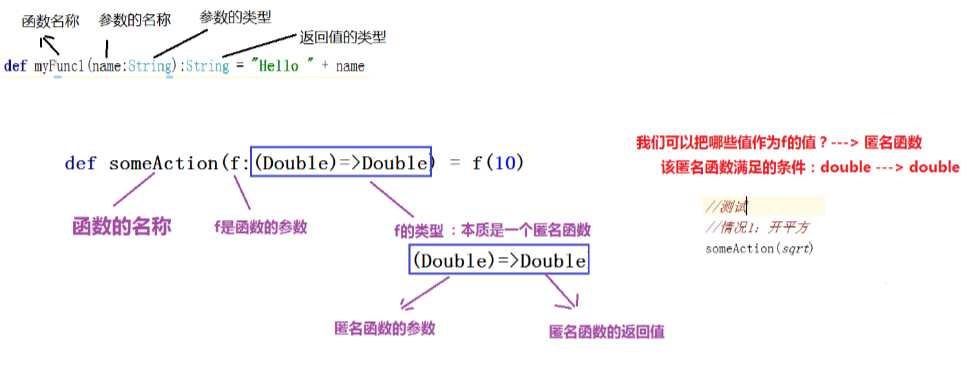===================== Scala函数式编程 ========================
一、Scala中的函数
(*) 函数是Scala中的头等公民,就和数字一样,可以在变量中存放函数,即:将函数作为变量的值(值函数)。
def myFunc1(name:String):String = "Hello " + name println(myFunc1("Tom")) def myFunc2():String = "Hello World" //值函数:把函数作为变量的值 val v1 = myFunc1("Tom") val v2 = myFunc2() //再将v1付给myFunc1 println(myFunc1(v1))
运行:
myFunc1: myFunc1[](val name: String) => String Hello Tom res0: Unit = () myFunc2: myFunc2[]() => String v1: String = Hello Tom v2: String = Hello World Hello Hello Tom res1: Unit = ()
二、匿名函数:没有名字的函数
//匿名函数:没有名字的函数 // 完整: def myFunc3(x:Int) = x * 3 (x:Int) => x*3 //举例:Array(1,2,3) ====> (3,6,9) Array(1,2,3).map((x:Int) => x*3)
运行:
res2: Int => Int = <function1>
res3: Array[Int] = Array(3, 6, 9)
三、高阶函数:带函数参数的函数
注意:把一个函数作为另外一个函数的参数值
四、高阶函数示例
//高阶函数 import scala.math._ //对数字10进行某种运算 //f : 就是执行的运算 def someAction(f:(Double)=>Double) = f(10) //测试 //情况1:开平方 someAction(sqrt) someAction(sin) //另一个例子 def mytest(x:Int,y:Int):Int = { x*y + 10} //定义一个高阶函数 def myFunction(f:(Int,Int)=>Int,x:Int,y:Int)=f(x,y) //调用 myFunction(mytest,2,3)

运行:
import scala.math._ someAction: someAction[](val f: Double => Double) => Double res0: Double = 3.1622776601683795 res1: Double = -0.5440211108893698 mytest: mytest[](val x: Int,val y: Int) => Int myFunction: myFunction[](val f: (Int, Int) => Int,val x: Int,val y: Int) => Int res2: Int = 16
数据:
val numbers = List(1,2,3,4,5,6,7,8,9,10)
map: 作用于列表中的每个元素,并且返回一个新的列表
numbers.map((i:Int) => i*2)
foreach: 跟map一样,没有返回值
numbers.foreach((i:Int) => i*2)
filter: 移除函数函数false的元素
返回所有能够被2整除的元素
numbers.filter((i:Int)=> i%2 ==0 )
zip: 把两个列表合并到一个列表中
List(1,2,3).zip(List(4,5,6))
数据:
val numbers = List(1,2,3,4,5,6,7,8,9,10)
partition: 能被2整除的放到一个分区中,不能被整除的放到另一个分区中
numbers.partition((i:Int) => i%2 ==0)
find: 第一个匹配条件的元素
找到第一个能被3整除的元素
numbers.find((x:Int) => x%3 == 0)
numbers.find(_ % 3 == 0)
flatten: 把一个嵌套的结构展开
List(List(1,2,3),List(4,5,6)).flatten
flatMap: 压平,结合了map和flatten的功能
var myList = List(List(1,2,3),List(4,5,6))
myList.flatMap(x=>x.map(_ *2))
分为两步
1、List(1,2,3),List(4,5,6) ===> 合并成一个List
2、再乘以2
运行以上例子的结果:
numbers: List[Int] = List(1, 2, 3, 4, 5, 6, 7, 8, 9, 10) res0: List[Int] = List(2, 4, 6, 8, 10, 12, 14, 16, 18, 20) res1: Unit = () res2: List[Int] = List(2, 4, 6, 8, 10) res3: List[(Int, Int)] = List((1,4), (2,5), (3,6)) res4: (List[Int], List[Int]) = (List(2, 4, 6, 8, 10),List(1, 3, 5, 7, 9)) res5: Option[Int] = Some(3) res6: Option[Int] = Some(3) res7: List[Int] = List(1, 2, 3, 4, 5, 6) myList: List[List[Int]] = List(List(1, 2, 3), List(4, 5, 6)) res8: List[Int] = List(2, 4, 6, 8, 10, 12) score: scala.collection.mutable.Map[String,Int] = Map(Mike -> 90) res9: Unit = () Map(Mike -> 85) res10: Unit = ()
五、闭包
六、柯里化:Currying
